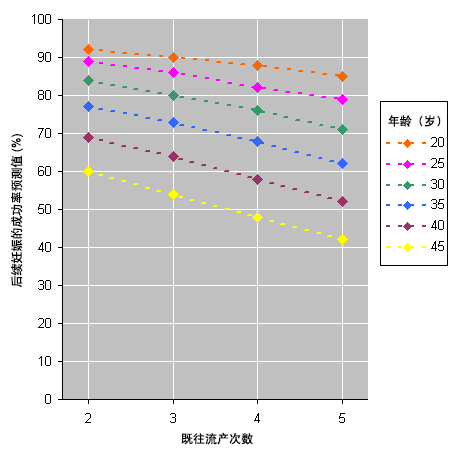欧洲人类生殖与胚胎学会以及美国生殖医学学会将复发性流产定义为 2 次或 2 次以上临床妊娠失败(即,通过超声或组织病理学证实)。[1]European Society of Human Reproduction and Embryology (ESHRE). Guideline on the management of recurrent pregnancy loss. Feb 2023 [internet publication].
https://www.eshre.eu/Guidelines-and-Legal
[2]Practice Committee of the American Society for Reproductive Medicine. Evaluation and treatment of recurrent pregnancy loss: a committee opinion. Fertil Steril. 2012 Nov;98(5):1103-11.
http://www.ncbi.nlm.nih.gov/pubmed/22835448?tool=bestpractice.com
在所有尝试妊娠、生育能力正常的夫妇中,复发性流产的发病率约为 1%,而在所有妊娠人群中,散发性非连续性流产发生率约为 15%-20%。[3]Stirrat GM. Recurrent miscarriage. Lancet. 1990 Sep 15;336(8716):673-5.
http://www.ncbi.nlm.nih.gov/pubmed/1975862?tool=bestpractice.com
流产包括任何在胚胎可存活的孕周前终止的妊娠,目前定义为孕 24 周末以前终止。 妊娠 12 周末前终止者称为早期流产,妊娠 13 周至不足 24 周终止者称为晚期流产。
评估可以从 2 到 3 次连续性流产后开始,因为在有 2、3 次或更多次流产的患者中,病因流行率相似。[4]Habayeb OM, Konje JC. The one-stop recurrent miscarriage clinic: an evaluation of its effectiveness and outcome. Hum Reprod. 2004 Dec;19(12):2952-8.
https://humrep.oxfordjournals.org/cgi/content/full/19/12/2952
http://www.ncbi.nlm.nih.gov/pubmed/15388685?tool=bestpractice.com
尽管有各种检查,但在 >50% 的复发性流产病例中未发现明显病因。[5]Quenby SM, Farquharson RG. Predicting recurring miscarriage: what is important? Obstet Gynecol. 1993 Jul;82(1):132-8.
http://www.ncbi.nlm.nih.gov/pubmed/8515913?tool=bestpractice.com
约有 70% 未发现病因的患者可在随后的妊娠成功分娩活产儿,这取决于女性的年龄以及既往流产的次数。[4]Habayeb OM, Konje JC. The one-stop recurrent miscarriage clinic: an evaluation of its effectiveness and outcome. Hum Reprod. 2004 Dec;19(12):2952-8.
https://humrep.oxfordjournals.org/cgi/content/full/19/12/2952
http://www.ncbi.nlm.nih.gov/pubmed/15388685?tool=bestpractice.com
[5]Quenby SM, Farquharson RG. Predicting recurring miscarriage: what is important? Obstet Gynecol. 1993 Jul;82(1):132-8.
http://www.ncbi.nlm.nih.gov/pubmed/8515913?tool=bestpractice.com
[Figure caption and citation for the preceding image starts]: 根据年龄和既往流产史预测下次妊娠的成功率BMJ Group编制;数据来源:Brigham SA, et al. Hum Reprod. 1999; 14: 2868-2871. [Citation ends].
与复发性流产明确相关的因素包括染色体异常、抗磷脂综合征,以及某些子宫结构异常(例如子宫纵隔)和特定易栓症。然而,对于以上大多数情况,尚未明确证实经治疗会降低后续妊娠中流产的风险。围绕其他情况与复发性流产的可能关联存在争议,包括免疫学因素、其他子宫异常(例如宫颈机能不全)、感染、男方因素以及内分泌因素。目前需要高质量且方法学可靠的研究指导这些患者的处理。[6]Hennessy M, Dennehy R, Meaney S, et al. Clinical practice guidelines for recurrent miscarriage in high-income countries: a systematic review. Reprod Biomed Online. 2021 Jun;42(6):1146-71.
https://www.rbmojournal.com/article/S1472-6483(21)00100-0/fulltext
http://www.ncbi.nlm.nih.gov/pubmed/33895080?tool=bestpractice.com
危险因素
母亲年龄的增加会降低成功活产的概率。既往有两次流产史的 20 岁女性,下次妊娠成功的几率是 92%,而既往有两次流产史的 45 岁女性,下次妊娠成功的几率仅 60%。[7]Brigham SA, Conlon C, Farquharson RG. A longitudinal study of pregnancy outcome following idiopathic recurrent miscarriage. Hum Reprod. 1999 Nov;14(11):2868-71.
https://humrep.oxfordjournals.org/cgi/content/full/14/11/2868
http://www.ncbi.nlm.nih.gov/pubmed/10548638?tool=bestpractice.com
父亲高龄似乎也与更高的自发性流产风险有关。[8]Kleinhaus K, Perrin M, Friedlander Y, et al. Paternal age and spontaneous abortion. Obstet Gynecol. 2006 Aug;108(2):369-77.
http://www.ncbi.nlm.nih.gov/pubmed/16880308?tool=bestpractice.com
[9]Nguyen BT, Chang EJ, Bendikson KA. Advanced paternal age and the risk of spontaneous abortion: an analysis of the combined 2011-2013 and 2013-2015 National Survey of Family Growth. Am J Obstet Gynecol. 2019 Nov;221(5):476.e1-7.
http://www.ncbi.nlm.nih.gov/pubmed/31128112?tool=bestpractice.com
[10]du Fossé NA, van der Hoorn MP, van Lith JMM, et al. Advanced paternal age is associated with an increased risk of spontaneous miscarriage: a systematic review and meta-analysis. Hum Reprod Update. 2020 Sep 1;26(5):650-69.
https://www.ncbi.nlm.nih.gov/pmc/articles/PMC7456349
http://www.ncbi.nlm.nih.gov/pubmed/32358607?tool=bestpractice.com
还与精子中染色体异常的发生率增加有关。[11]Slama R, Bouyer J, Windham G, et al. Influence of paternal age on the risk of spontaneous abortion. Am J Epidemiol. 2005 May 1;161(9):816-23.
https://www.ncbi.nlm.nih.gov/pmc/articles/PMC7456349
http://www.ncbi.nlm.nih.gov/pubmed/15840613?tool=bestpractice.com
在一项系统评价和荟萃分析中,40-44 岁男性和 ≥45 岁男性(与 25-29 岁男性相比)使 <20 周妊娠丢失风险分别增加 23% 和 43%。[10]du Fossé NA, van der Hoorn MP, van Lith JMM, et al. Advanced paternal age is associated with an increased risk of spontaneous miscarriage: a systematic review and meta-analysis. Hum Reprod Update. 2020 Sep 1;26(5):650-69.
https://www.ncbi.nlm.nih.gov/pmc/articles/PMC7456349
http://www.ncbi.nlm.nih.gov/pubmed/32358607?tool=bestpractice.com
初孕妇及之前所有妊娠均成功的女性发生流产的风险仅为 5%,而既往有流产史的女性,发生流产的风险为 24%。[12]Regan L, Braude PR, Trembath PL. Influence of past reproductive performance on risk of spontaneous abortion. BMJ. 1989 Aug 26;299(6698):541-5.
https://www.ncbi.nlm.nih.gov/pmc/articles/PMC1837397
http://www.ncbi.nlm.nih.gov/pubmed/2507063?tool=bestpractice.com
其他研究同样显示,随着既往流产次数的增加,流产率有增加趋势。[7]Brigham SA, Conlon C, Farquharson RG. A longitudinal study of pregnancy outcome following idiopathic recurrent miscarriage. Hum Reprod. 1999 Nov;14(11):2868-71.
https://humrep.oxfordjournals.org/cgi/content/full/14/11/2868
http://www.ncbi.nlm.nih.gov/pubmed/10548638?tool=bestpractice.com
[13]Ogasawara M, Aoki K, Okada S, et al. Embryonic karyotype of abortuses in relation to the number of previous miscarriages. Fertil Steril. 2000 Feb;73(2):300-4.
http://www.ncbi.nlm.nih.gov/pubmed/10685533?tool=bestpractice.com
因此,流产的风险与既往妊娠结局直接相关。
复发性流产会给患者带来很大压力,所以在进行医学研究的同时,应当提供合适的治疗、患者教育,咨询以及支持。

